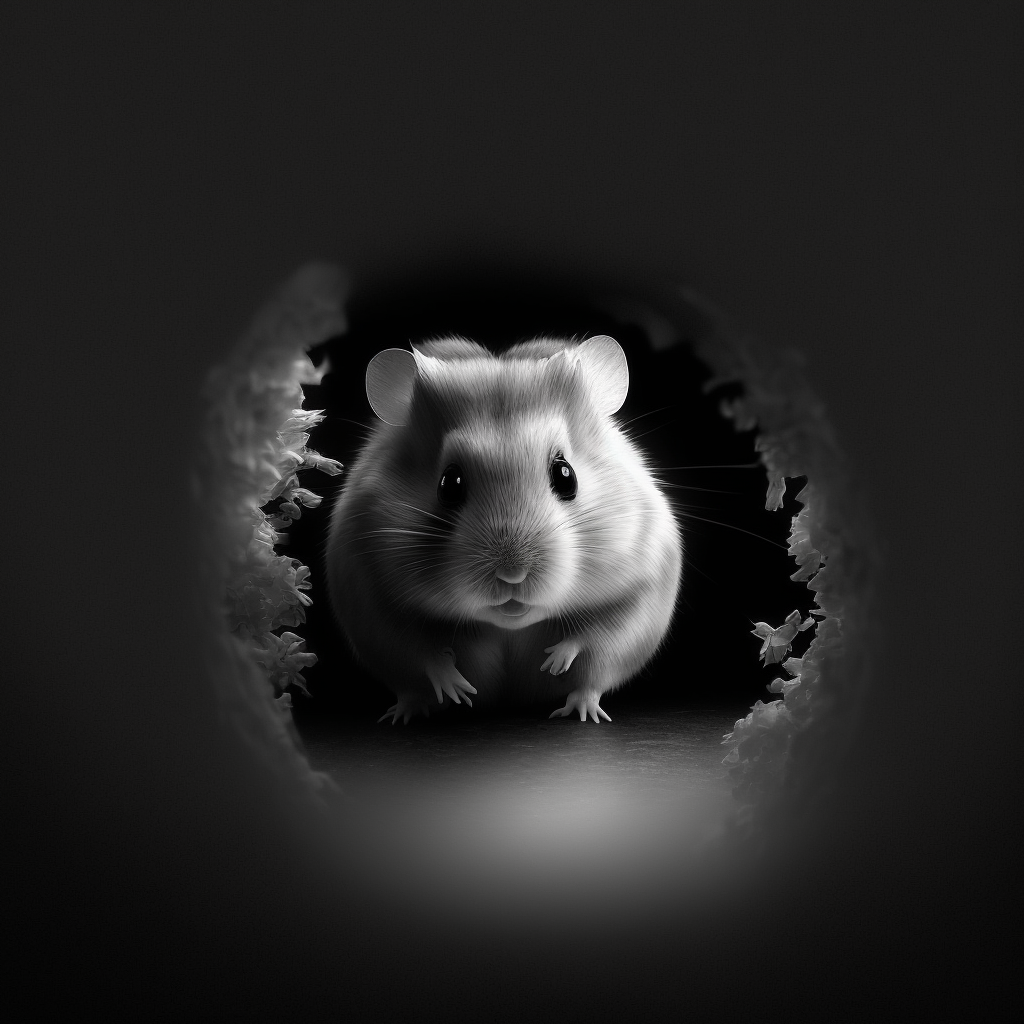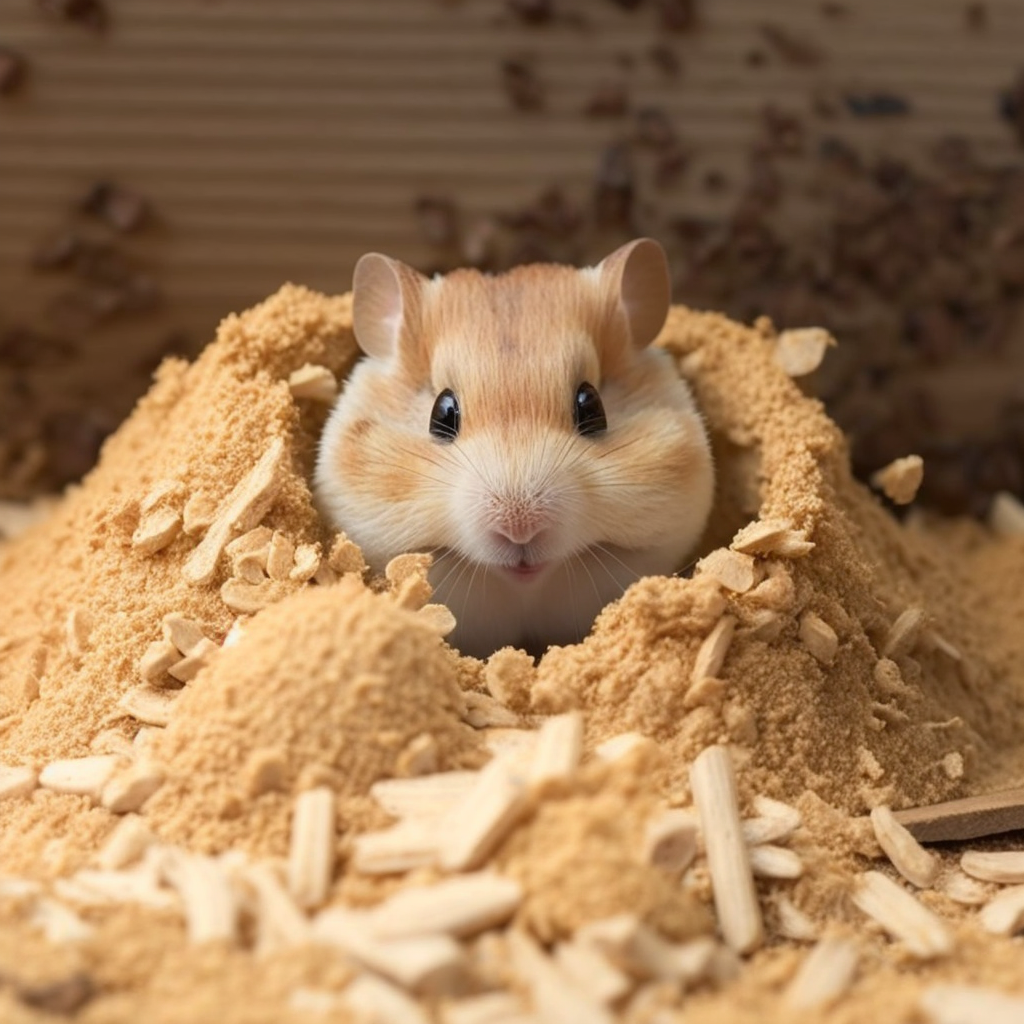Think you know everything about hamsters? Think again! These tiny furballs have some fascinating secrets that might surprise you. Hamsters are popular pets known for their adorable appearance and playful nature. However, there’s a lot more to these small rodents than meets the eye. In this article, we will explore some surprising and fun facts about hamsters that will leave you amazed.
Table of Contents
Fact 1: Hamsters are nocturnal creatures
Unlike humans who are diurnal creatures, hamsters are naturally adapted to being active during the night and sleeping during the day. Hamsters are most active during the evening and early morning hours when they venture out of their nests in search of food, water, and exercise. Their keen senses of smell and hearing help them navigate their environment even in the darkness. It’s not uncommon to hear the sound of a hamster running on its wheel or rustling in its cage during the night.

One of the reasons behind their nocturnal behavior is their evolutionary adaptation to living in the wild. Hamsters are prey animals and being active during the night helps them avoid predators that are active during the day. In the wild, hamsters typically live in burrows and come out at night to forage for food and explore their surroundings.
Fun Fact: Hamsters love running on hamster wheels in the middle of the night! It’s their favorite form of exercise and a way to release their pent-up energy.
Fact 2: Hamsters have cheek pouches for storage
Hamsters are known for their unique ability to stuff food in their large cheek pouches for later consumption. These cheek pouches are located on both sides of their mouths and can stretch to an impressive size, allowing them to carry a significant amount of food. Hamsters use their cheek pouches to gather food from their environment and transport it to their nests or hideouts for safekeeping.
Hamsters are hoarders by nature and their cheek pouches play a crucial role in their survival strategy. They can collect and store food in their cheek pouches for times when food is scarce or during hibernation periods. Hamsters have been known to stuff their cheek pouches with various items, including seeds, grains, fruits, vegetables, and even treats or toys.
Fun Fact: Hamsters can carry up to half of their body weight in their cheek pouches, which is an impressive feat considering their small size!
Fact 3: Hamsters are incredible escape artists.
Hamsters are notorious for their escape artist skills. Despite their small size, they are experts at finding creative ways to escape from their cages and explore their surroundings. Hamsters are agile and can squeeze through small gaps or openings that seem impossible for their size.
Hamsters are known to chew on cage bars, dig tunnels, or climb walls to find an escape route. They can also use their sharp teeth and strong jaws to gnaw on cage locks or latches, making their way to freedom. Hamsters are highly curious animals and their adventurous nature can sometimes lead them to seek new territories outside their cages.
Fun Fact: Hamsters have been known to escape from cages by unscrewing the cage lids or sliding open the cage doors with their paws!
Fact 4: Hamsters have a keen sense of smell
Hamsters have a highly developed sense of smell, which they use to navigate their environment and communicate with each other. Hamsters have scent glands on various parts of their bodies, including their cheeks, hips, and bellies, which they use to mark their territory and communicate with other hamsters.
Hamsters rely heavily on their sense of smell to locate food, find their way around their habitat, and recognize familiar scents. They can also detect potential dangers or predators through their sense of smell, helping them stay alert and safe in their environment.
Hamsters have an incredible ability to remember scents and associate them with certain experiences or events. For example, they can remember the scent of their favorite treats or the smell of their owner, which helps them form strong bonds and recognize familiar faces. Hamsters also use their sense of smell to communicate with other hamsters, leaving scent marks or signals to convey messages about their territory, mating status, or emotional state.
Fun Fact: Hamsters have a highly developed sense of smell that is estimated to be 100,000 times better than that of humans!
Fact 5: Hamsters have different species and varieties
Hamsters come in various species and varieties, each with its unique characteristics and traits. Some of the most common species of hamsters kept as pets include Syrian hamsters, Dwarf hamsters, Roborovski hamsters, Campbell’s hamsters, and Chinese hamsters.
Syrian hamsters, also known as Golden hamsters, are the largest species of hamsters and are known for their solitary nature. They are usually kept as solitary pets as they do not tolerate living with other hamsters. Syrian hamsters are known for their distinctive appearance, with a golden coat and large, round ears.
Dwarf hamsters, on the other hand, are smaller in size and are known for their social nature. There are several species of Dwarf hamsters, including Campbell’s, Roborovski, and Chinese hamsters. Campbell’s and Roborovski hamsters are known for their high energy levels and are very active, while Chinese hamsters are known for their long tails and unique appearance.
Fun Fact: Dwarf hamsters are known for their impressive ability to run on their wheel for hours without getting tired, thanks to their boundless energy!
Fact 6: Hamsters are prolific breeders
Hamsters have a reputation for being prolific breeders, with females capable of breeding at a young age and producing several litters in a year. Female hamsters can have a gestation period of around 16-18 days, and they can give birth to an average of 6-12 pups in a single litter.
Hamsters have a unique reproductive system that allows them to breed quickly and adapt to their changing environment. Female hamsters can go into heat shortly after giving birth, and they can become pregnant again within a few days. This rapid reproductive cycle allows hamsters to breed and multiply their population quickly in the wild.
As pets, it’s important to be aware of the breeding potential of hamsters and take appropriate measures to prevent unwanted litters. Properly sexing and separating male and female hamsters is essential to avoid unplanned pregnancies and overcrowding in their cages.
Fun Fact: Hamsters have a shorter gestation period compared to many other mammals, making them efficient breeders and able to produce multiple litters in a year!
Fact 7: Hamsters have unique dental characteristics
Hamsters have unique dental characteristics that are essential to their survival in the wild. Hamsters have continuously growing teeth that require constant wear to maintain proper dental health. Their front incisor teeth grow throughout their lives and are constantly worn down through gnawing on hard objects.
Hamsters are known to gnaw on various materials, including wooden toys, gnawing blocks, and hard foods like seeds and nuts, to keep their teeth at an optimal length. Gnawing also helps them strengthen their jaw muscles and prevent dental issues such as overgrown teeth or dental malocclusions.
As pet owners, it’s important to provide appropriate chew toys and hard foods to hamsters to help them wear down their teeth naturally and maintain good dental health. Regular dental check-ups by a qualified veterinarian are also essential to detect any dental issues early on and provide appropriate treatment.
Fun Fact: Hamsters’ teeth grow at an average rate of 4-5 inches per year, which is equivalent to about 0.3-0.4 inches per month!
Fact 8: Hamsters have unique behaviors and habits
Hamsters have intriguing behaviors and habits that make them fascinating pets to observe and interact with. Here are some interesting facts about hamster behaviors:
Hoarding: Hamsters have a natural instinct to hoard food and other small items in their environment. In the wild, hamsters store food in their burrows to sustain them during times of scarcity. As pets, hamsters may hoard food in their bedding or hide it in their cage for later consumption.
Burrowing: Hamsters are burrowers by nature, and they love to dig and create tunnels in their bedding or substrate. Burrowing provides them with a sense of security and allows them to create their own cozy hideouts.
Nocturnal activity: Hamsters are nocturnal animals, which means they are most active during the night and sleep during the day. This is because they are naturally adapted to living in the wild, where they forage for food and explore their surroundings under the cover of darkness.
Cheek pouches: Hamsters have large cheek pouches that they use to carry food and bedding materials to their burrows. These cheek pouches can stretch and expand to accommodate a surprising amount of items, allowing hamsters to transport food and nesting materials efficiently.
Scent marking: Hamsters use scent marking as a way to communicate with other hamsters and mark their territory. They may rub their scent glands on various objects in their environment or leave urine marks to convey messages to other hamsters.
Fun Fact: Hamsters have been known to hoard unusual items such as paper clips, cotton balls, and even small toys in their cheek pouches!
Fact 9: Hamsters require proper care and attention
As pets, hamsters require proper care and attention to ensure their health and well-being. Here are some essential care tips for hamster owners:
- Cage and bedding: Hamsters need a cage that is spacious, well-ventilated, and escape-proof. The cage should be equipped with appropriate bedding material, such as aspen shavings or paper-based bedding, for burrowing and nesting. Hamsters also need a hideout or shelter in their cage where they can feel safe and secure.
- Diet: Hamsters require a balanced and nutritious diet to maintain their health. A good quality hamster food, which consists of a mix of seeds, grains, and pellets, should be the main component of their diet. Fresh fruits and vegetables can also be offered as occasional treats. Fresh water should be available at all times in a water bottle with a sipper tube.
- Exercise and enrichment: Hamsters are active animals that need regular exercise and mental stimulation. Providing a hamster wheel or exercise ball in their cage can help them get the exercise they need. Hamsters also enjoy climbing, digging, and exploring, so providing toys, tunnels, and hiding spots in their cage can help keep them mentally stimulated.
- Regular cleaning: Hamsters are known to be clean animals, and their cage should be cleaned regularly to maintain their hygiene and prevent odors. Cleaning the cage, removing soiled bedding, and providing fresh bedding is essential to keep the hamster’s environment clean and healthy.
- Health care: Hamsters should receive regular health check-ups from a qualified veterinarian to detect and treat any potential health issues early on. Hamsters are prone to dental issues, respiratory problems, and obesity, so proper health care is crucial to ensure their well-being.
Fun Fact: Hamsters have been known to escape from their cages and find creative hiding spots in their surroundings, so it’s important for hamster owners to regularly check and secure their cages to prevent escapes!
Fact 10: Hamsters can make wonderful pets
Despite their small size, hamsters can make wonderful pets for the right person or family. They are adorable, fascinating, and can bring joy and companionship into your life.
Here are some reasons why hamsters can make great pets:
- Low maintenance: Hamsters are relatively low-maintenance pets compared to larger animals like dogs or cats. They don’t require daily walks or grooming, and their cage cleaning and feeding can be easily managed with a routine schedule.
- Compact size: Hamsters are small animals, which makes them suitable for small living spaces like apartments or dorm rooms. They can be kept in a relatively small cage without taking up too much space, making them ideal for people with limited living arrangements.
- Independent nature: Hamsters are solitary animals and are content with their own company. They don’t require constant attention or social interaction, which makes them suitable for people with busy lifestyles or those who prefer a more independent pet.
- Fascinating behaviors: Hamsters have unique and intriguing behaviors that can be entertaining and fascinating to observe. From hoarding food to burrowing, watching their behaviors can be a source of joy and amusement.
- Bonding potential: While hamsters are solitary animals, they can still form bonds with their owners through regular handling, gentle care, and positive interactions. Building a bond with your hamster can be a rewarding experience and can create a special connection between you and your pet.
- Educational value: Hamsters can also be great pets for children, as they provide an opportunity to learn about responsibility, empathy, and animal care. Caring for a hamster can teach children important life skills and help them develop a sense of compassion towards animals.
In conclusion, hamsters are small but fascinating creatures that can make wonderful pets for the right person or family. They have unique characteristics, behaviors, and care requirements that make them interesting and enjoyable companions. As with any pet, it’s essential to research and understand their needs, provide proper care and attention, and consult with a qualified veterinarian for their health and well-being. If you’re considering a pet, and you’re looking for a small, low-maintenance, and independent companion, a hamster might be the perfect addition to your household!
Frequently Asked Questions re: Fun Facts About Hamsters
Q: What are hamsters? A: Hamsters are small, nocturnal rodents that are commonly kept as pets. They belong to the family Cricetidae and are known for their cute appearance, fluffy coats, and short tails.
Q: What are the different types of hamsters? A: There are several different species and breeds of hamsters that are commonly kept as pets, including Syrian hamsters, Dwarf hamsters (such as Roborovski, Campbell’s, and Winter White), and Chinese hamsters.
Q: What do hamsters eat? A: Hamsters are omnivores and eat a variety of foods, including commercial hamster food, fresh fruits and vegetables, seeds, nuts, and insects. It’s important to provide a balanced and nutritious diet for your hamster to ensure their health and well-being.
Q: How long do hamsters live? A: The lifespan of a hamster varies depending on the species and care provided, but on average, hamsters can live for 2 to 3 years. Some species, such as Syrian hamsters, can live slightly longer, up to 3 to 4 years, with proper care.
Q: What kind of housing do hamsters need? A: Hamsters need a suitable cage or enclosure that provides enough space for them to move, play, and explore. The cage should have a solid bottom, good ventilation, and be equipped with a wheel for exercise, hiding spots, and nesting materials. It’s important to choose the right size and type of cage for your hamster’s specific needs.
Q: Can hamsters be kept together? A: Syrian hamsters are solitary animals and must be kept alone, as they are known to be aggressive towards each other. Dwarf hamsters, on the other hand, can sometimes be kept together in same-sex pairs or small groups, but careful introductions and monitoring are necessary to ensure they get along.
Q: How do I handle my hamster? A: Hamsters can be gently handled by scooping them up with both hands and supporting their body. It’s important to approach them slowly and avoid sudden movements, as they can be skittish and easily scared. Regular, gentle handling can help your hamster become more comfortable with human interaction.
Q: Do hamsters need veterinary care? A: Yes, hamsters, like all animals, can benefit from regular veterinary care. It’s important to find a qualified veterinarian who is experienced in treating small animals and can provide medical check-ups, vaccinations, and treatment for any health issues that may arise.
Q: Can hamsters be trained or socialized? A: Hamsters are generally not trainable like dogs or cats, but they can be socialized through gentle handling and positive interactions. Spending time with your hamster, talking to them, and offering treats can help them become more comfortable with human interaction.
Q: Can hamsters be housed with other pets? A: Hamsters should be kept separate from other pets, such as cats, dogs, or larger rodents, as they are small and vulnerable. They can be prey for other animals, and interactions with other pets can result in injury or stress for the hamster.
I hope these FAQs help provide some answers to common questions about hamsters! Remember to always do your research, provide proper care, and consult with a qualified veterinarian for the best care practices for your furry little friend.


